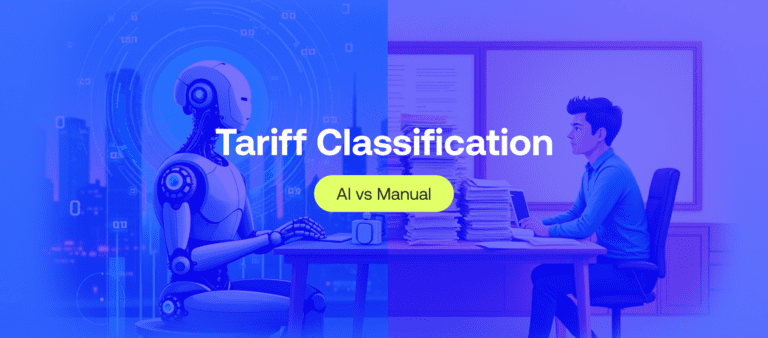Fast & Accurate ENS GB & EU ICS2 Solutions Built for You.
Common Customs Issues Faced by Importers and Exporters in 2024
-
Freya Jane
- Director of Customer's Success
Global trade plays a pivotal role in a country’s economy. A country’s focus on imports signifies robust local demand and a thriving economy, while a significant export volume creates numerous job opportunities. Thus, to keep the economy stable, it is imperative to maintain a balance between imports and exports, which is heavily influenced by the volume of trade.
The volume of global trade is increasing progressively. As per Global Trade Outlook’s recent report
“The volume of global merchandise trade is predicted to increase by 2.6% in 2024 and 3.3% in 2025, after declining by 1.2% more than anticipated in 2023.”
With the prediction of this massive rise in the number of trades, there come a lot of hurdles and challenges that importers and exporters have to deal with to become successful in the trading world.
When you are well informed about all the customs issues that come across importers and exporters prior to trading, you can make better plans on how to tackle them. In this blog, we will take you through all the common challenges and equip you with simple solutions.
Changes in customs regulations in 2024
Before delving into the challenges, let’s first examine any modifications in the trading and customs regulations. There exist separate regulations for both imports and exports:
- Customs import regulations
- Customs export regulations
The UK Government introduced a series of changes in the Border Target Operating Model for 2024. These changes are specifically designed for importers of animals, plants, and Food & Feed Systems.
- January 31, 2024: There are 3 risk categories for the products (Low, medium, and high). Export health certifications are required for medium and high risk commodities. Certain products, such as medications, plastics, or cosmetics containing animal ingredients, might need to be declared with the IPAFFS. A phytosanitary certificate and an IPAFFS pre-notification for medium and high risk commodities are required for plants and plant products. Fruits and vegetables in the EU are mostly low-risk.
- April 30, 2024: Depending on the risk level, document and physical checks at designated Border Control Posts. Inspections of EU plants and products deemed high risk are moved to specific Border Control Posts.
- Oct 31, 2024: Safety and security declarations for imports into the EU will begin on this date. Details will be provided closer to the date.
Curious to learn more about IPAFFS? Click here!
Common customs issues
Customs clearance involves ensuring that all imported goods are compliant with the governing rules and regulations. Most traders can find it problematic and complicated, leading to customs clearance delays. Major customs declaration problems are discussed below:
Customs documentation

Handling custom documents for imports and exports is a major challenge as it requires keen attention and time to be done accurately.
According to a report by the Federation of Small Business (FSB), “Nearly 10% of small businesses in the UK have come to an end in the previous five years due to complicated customs documents.”
The common documents are the following:
Bill of lading
The bill of lading acts as a contract between the carrier and shipper. It provides details about tracking the parcel and confirms that the products are received for the shipment.
Want to learn how you can automate your Bill of Lading? Click here!
The common bill of lading issues are:
- Missing or incorrect information, which can lead to clearance delays.
- Getting the original paper copy for release can be costly and time-consuming.
Commercial invoice
The commercial invoice provides information about the goods’ quantity and total value. Moreover, it helps calculate the amount of duty and tax to be paid.
The common commercial invoice issues are:
- Missing details, such as product descriptions or origin information, can result in clearance rejections.
- Inconsistencies between the invoice value and the real value may result in delays and inspections by customs.
Packing list
A packing list is a comprehensive inventory of the shipment that includes the quantities and contents of every package.
The common packing list issues are:
- Discrepancies in quantity or inaccurate itemisation can result in physical inspection delays.
- The missing packing list, which can completely impede clearance
Certificate of origin
The certificate of origin shows the country in which the goods are produced. It helps to determine whether there are any trade restrictions or if a trade agreement is eligible.
The common certificate of origin issues are:
- Acquiring them may necessitate intricate procedures and authentication by governmental entities, resulting in prolonged periods of time.
- Errors in the certificate may give rise to customs rejections.
Adjusting to new customs rules and regulations

Customs rules and regulations for importing and exporting countries can change anytime, becoming a nightmare for global traders. Thus, having access to AI-driven customs declaration software that automatically adjusts to any updates is a key to stress-free trading. iCustoms is at the top of the market in this regard, providing you with a sophisticated AI-driven tool, i.e. CDS, to keep you alert of all the fluctuations in customs regulations.
The following are some ways that importers and exporters in international trading face difficulties while responding to new customs laws and regulations:
Intricacy and Insufficient clarity
- Updated rules may be hidden: If new regulations are not extensively announced, businesses may not be aware of significant modifications.
- Uncertainty in interpretation: New rules may be written in technical language, making it difficult to understand their precise intent and scope.
- Differential implementation: Uncertainty arises from the possibility that new regulations may be implemented differently in various nations or even within the same customs agency.
Limitations on time and resources
- Adaptation costs: Organisations must devote time and money to learning new rules, revising protocols, and retraining employees.
- Shipments delayed: Uncertainty about new rules may cause delays at customs as documentation is examined or resubmitted.
- Enhanced compliance costs: New regulations may require additional paperwork or inspections, which would raise operating expenses.
Competitive disadvantage
Unequal information access: Smaller organisations may be at a disadvantage since larger enterprises with specialised compliance teams may adjust more quickly.
Supply chain disruption: Delays caused by adjusting to new regulations may affect delivery timetables and existing supply networks.
Handling international payments
It poses a number of difficulties for international traders. The common customs issues are discussed below:
For importers:

- Limited payment options: Exporters may prefer certain payment options, which can be costly and complicated for importers.
- Currency fluctuations: Changes in currency rates can cause importers to incur unforeseen expenses.
- Payments and visibility delays: Long international payment clearing periods might provide importers cash flow problems. This can impact the schedules for their own payments.
- Fraud risk: International transactions have a higher risk of fraud than compared to domestic payments. Importers must exercise extreme caution to ensure they are not paying for things that do not exist.
For exporters:

- Payment loss risk: It is always possible that importers will not pay after obtaining the goods, which could result in financial losses for exporters.
- Delayed processing: The duration required for importers’ payments to be deposited into their accounts can have an effect on exporters’ cash flow.
- Unknown costs: For international transactions, there is a possibility that banks or other organisations may impose extra charges.
- Difficulties with currency conversion: Exporters may have to control their exposure to exchange rate changes in addition to navigating currency exchange procedures.
Feeling lost in customs complexity?
Automate your import/export processes with iCustoms software!
Free Trade Agreement
A free Trade Agreement reduces barriers to trade between two or more countries. Under this agreement, goods are sold or bought across borders with little to no hassle.
As an international trader, you must be aware of all the advantages and disadvantages of this agreement.
The common issues of FTAs faced by traders are the following:
- Complex rules
- Higher competition
- Potential disputes
Custom duty and tax
Customs duties and taxes are applied to imported and exported goods. Their primary purpose is to protect local industries and generate government revenue. Calculating customs duties and taxes is extremely complicated and requires meticulous attention to avoid errors.
The common custom duty problems faced by importers and exporters are the following:
- Cargo classification: It might be difficult to determine the correct code for your products, which can cause delays and inaccurate duty estimates.
- Duty fluctuation: Forecasting expenses and establishing pricing is difficult when taxes and duties fluctuate.
- Hidden fees: Unexpected expenses for storage, customs brokers, or inspections might reduce earnings.
Takeaway
Transporting goods across borders presents numerous obstacles, particularly customs issues. Nevertheless, by possessing the appropriate knowledge and resources, you can effectively manage the complexities of global commerce. It entails carefully managing documents, remaining up to date on customs rules, meticulously computing customs duties and taxes, and using appropriate tactics for international payments.
With the help of iCustoms, you can confidently handle the complexity of customs. Do not let customs functions derail your international goals. Reach out to iCustoms right now to start enjoying a more seamless and effective trade experience!

Tired of customs clearance issues?
Customs software automates submissions, minimises errors, and speeds up clearances.
FAQ's
What are the most common problems with customs clearance?
The most common problem with customs clearance is delayed shipment because of inaccurate or incomplete customs declarations.
How to handle customs problems?
The best ways to resolve customs challenges are to ensure correct documentation, follow the rules, and swiftly address any difficulties with customs authorities.
How risk management system in customs work?
Through the analysis of data, risk management systems at customs enable authorities to efficiently allocate resources and reduce risks to trade integrity and national security.
Why determining country of origin for import is important?
Establishing the country of origin of imports is essential for imposing trade agreements, determining taxes, and implementing laws pertaining to product safety and quality requirements.

